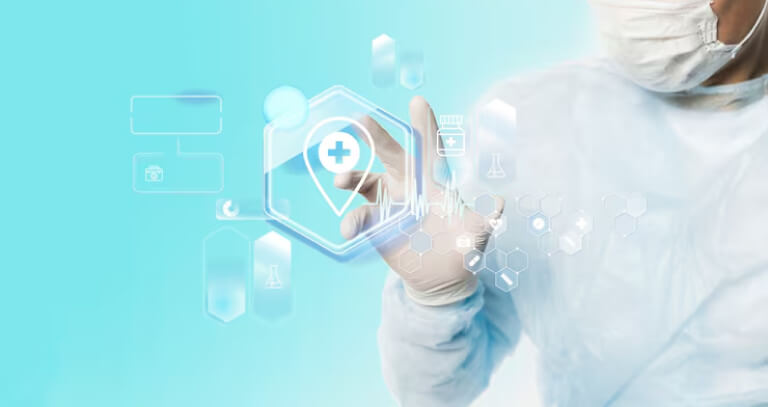Step-by-Step Breakdown of the Medical Software Development Process
Ditstek Blogs
Building medical software is a lot more than just writing code—it’s about creating tools that save lives, improve patient outcomes, and streamline healthcare processes. The medical software development process is the framework that brings these solutions to life, from conceptualizing an idea to delivering a final product that’s secure, compliant, and user-friendly.
Whether you're developing EHR systems, telemedicine platforms, or AI-powered healthcare tools, every step of the development process plays a critical role in ensuring the software meets industry standards while addressing the unique needs of healthcare providers and patients alike.
In this guide, we’ll walk you through the medical software development process step by step. You'll get a clear roadmap on how to turn a great idea into a reliable, scalable, and fully compliant solution.
Let’s dive in and take a look at what it really takes to build software that works for healthcare—practically, not just theoretically.
What is Medical Software Development?
Medical software development refers to the process of designing, building, and maintaining software solutions tailored for the healthcare industry. These solutions help streamline operations, improve patient care, and ensure compliance with industry regulations like HIPAA, GDPR, and FDA guidelines.
Medical software can range from electronic health records (EHR) systems that store patient data to telemedicine platforms, AI-powered diagnostics, and hospital management systems. The goal is to create secure, scalable, and efficient applications that enhance the overall healthcare experience for both providers and patients.
Medical software development typically involves:
- Planning & Requirement Analysis – Understanding the needs of healthcare providers and regulatory compliance.
- Design & Development – Building user-friendly and scalable solutions.
- Testing & Validation – Ensuring security, accuracy, and compliance with industry standards.
- Deployment & Maintenance – Rolling out the software and continuously updating it for performance and security.
With the rise of digital health, AI, and IoT in healthcare, medical software development has become an essential part of modern healthcare innovation.
Maximize ROI with Next-Gen Medical Software Development!
Develop secure, scalable medical software to enhance efficiency, improve patient care, and maximize your ROI.
Medical Software Development Market Trends & Stats

The medical software industry is rapidly growing, driven by advancements in digital health, AI, and telemedicine. Here are some key statistics that highlight its impact:
Global Market Growth
- The global healthcare software market is projected to reach $104.1 billion by 2030, growing at a CAGR of 13.1% from 2023.
- The electronic health records (EHR) market alone is expected to surpass $40 billion by 2027 due to increasing adoption in hospitals and clinics.
Adoption of Telemedicine & AI
- The telemedicine market is expected to grow to $225 billion by 2030, fueled by rising demand for remote healthcare.
- AI in healthcare is projected to reach $188 billion by 2030, as AI-driven diagnostics, automation, and predictive analytics become mainstream.
Regulatory & Compliance Trends
- Over 80% of healthcare organizations prioritize HIPAA and GDPR compliance in their software development.
- The FDA approved 91 AI-based medical devices as of 2023, showing a growing trend toward AI-driven medical software.
Cybersecurity in Healthcare
- Over 45 million patient records were exposed in healthcare data breaches in 2023, highlighting the critical need for secure medical software.
Types of Medical Software Development
Medical software development covers a wide range of solutions tailored to different healthcare needs. From patient management to AI-powered diagnostics, here are some of the most common types:
| Type | Purpose | Key Features | Examples |
| Electronic Health Records (EHR) & Electronic Medical Records (EMR) Software | Stores and manages patient medical history, prescriptions, lab results, and treatment plans. |
|
|
| Telemedicine & Telehealth Software | Enables remote consultations between doctors and patients via video calls, chat, and messaging. |
|
|
| Medical Billing & Revenue Cycle Management (RCM) Software | Automates medical billing, insurance claims processing, and financial reporting. |
|
|
| Healthcare CRM (Customer Relationship Management) Software | Enhances patient engagement, scheduling, and communication with healthcare providers. |
|
|
| Medical Imaging & Diagnostic Software | Assists in analyzing medical images (MRI, CT scans, X-rays) for better diagnostics. |
|
|
| Hospital Management Software (HMS) | Centralized system for managing hospital workflows, patient records, and administrative tasks. |
|
|
| AI-Powered & Predictive Analytics Software | Uses AI and machine learning to predict patient risks, suggest treatments, and analyze health trends. |
|
|
| Wearable & Remote Patient Monitoring Software | Tracks real-time patient vitals using wearable devices and IoT-powered sensors. |
|
|
Want to Develop Medical Software to Boost Your Healthcare Operations?!
Build a custom medical software solution to streamline operations, enhance patient care, and improve efficiency.
Step-by-Step Breakdown of the Medical Software Development Process
Let’s break down the medical software development process into six critical stages, each playing a vital role in delivering a secure, efficient, and high-performing solution.
1. Requirement Analysis & Planning
Imagine launching a medical software product without a proper plan. Disaster, right? This phase is where we lay the foundation.
- Understanding the Problem: Every software starts with a problem that needs solving. Are we streamlining hospital workflows? Improving remote patient monitoring? Reducing medical errors? The answers shape the software’s core functionality.
- Regulatory Compliance from Day One: Unlike standard software, medical applications must meet strict regulations like HIPAA (USA), GDPR (Europe), or FDA (if it’s a medical device software). Ignoring these at the start means costly rework later.
- Technology Stack & Architecture: Choosing between cloud-based or on-premise solutions, selecting programming languages (ASP.NET, Java, Python), and defining system architecture ensures the software is scalable, secure, and future-proof.
This phase isn’t just about planning—it’s about setting up for success.
2. UI/UX Design & Prototyping
Medical professionals don’t have time to figure out clunky interfaces. Their software needs to be fast, intuitive, and distraction-free.
- User-Centric Design: We create wireframes and prototypes, ensuring the design makes sense for doctors, nurses, and patients.
- Accessibility Matters: Can an elderly patient use it? What about someone with visual impairments? We ensure everyone can navigate the system effortlessly.
- Feedback Loop: Before writing a single line of code, we gather feedback from healthcare professionals to fine-tune the design.
A bad UI/UX in medical software can lead to frustration, miscommunication, and even life-threatening mistakes. This phase ensures seamless interactions.
3. Software Development & Integration
Once the foundation is set, it’s time to build the actual software. This stage is where ideas turn into real-world solutions. Whether it's a scalable cloud-based platform or an on-premise hospital management system, the right development approach can mean the difference between a seamless, high-performing application and a system that frustrates users with inefficiencies.
Choosing the Right Development Approach
The development approach you select directly impacts the scalability, performance, and future adaptability of your medical software. So, how do you choose the right approach?
1. Monolithic Architecture
This traditional approach means the software is developed as a single unit, where all components are tightly integrated. While monolithic systems are generally easier to develop at first, they can become cumbersome as the software grows. If your healthcare application is relatively small and you don’t anticipate frequent updates, a monolithic approach might still be a valid option. But as the system scales, managing it can become a nightmare.
2. Microservices Architecture
For more complex and scalable applications, microservices are the way to go. In a microservices approach, the application is broken down into smaller, independent services—each responsible for a specific function. This allows for greater flexibility, enabling you to update individual components without disrupting the entire system. With healthcare systems, where multiple departments (billing, patient care, pharmacy) need different functionalities, microservices offer a clean, efficient solution to maintain and expand the software as your needs evolve.
3. Cloud-Based Systems
A cloud-based approach allows your medical software to be accessed from anywhere with an internet connection—making it ideal for healthcare providers who need real-time access across multiple locations. This architecture supports rapid scaling, provides enhanced security, and reduces infrastructure costs. It's especially beneficial for software aimed at providing remote care or telemedicine services, where accessibility and flexibility are key.
4. Serverless Computing
With serverless, you don’t worry about managing servers. This cloud-native approach is perfect for healthcare apps that require quick scaling based on demand. For example, during flu season, the app might handle a spike in appointments and consultations without any performance issues. Serverless computing eliminates infrastructure headaches, reducing the time spent on maintenance and costs.
5. AI-Powered Systems
In healthcare, the power of Artificial Intelligence can be harnessed for applications like diagnostic tools, predictive analytics, and personalized treatment plans. By incorporating machine learning algorithms, AI can make medical decisions faster, more accurately, and often at a lower cost.
Integration with Third-Party Systems
Medical software doesn’t operate in isolation—it needs to communicate with various systems to provide a seamless user experience for doctors, hospitals, and patients.
Key Integrations
| EHR/EMR Systems (Epic, Cerner, MEDITECH, etc.) | Ensures patient records remain centralized and accessible. |
| Telemedicine Platforms | Enables remote consultations by integrating with video conferencing APIs. |
| Billing & Insurance Systems | Automates claims processing and reduces administrative burden. |
| Wearables & IoT Devices | Syncs real-time patient vitals for continuous monitoring. |
| Pharmacy Management Systems | Facilitates e-prescriptions and medication tracking. |
Why Integration Matters?
- Doctors shouldn’t have to switch between multiple systems to access patient data.
- Real-time data synchronization prevents errors and enhances decision-making.
- Compliance risks are reduced when data flows securely between systems.
4. Security & Compliance in Medical Software
A single security lapse in a medical application can expose millions of patient records, leading to legal repercussions and reputational damage. That’s why security and compliance must be built into the development process, not added as an afterthought.
Security Best Practices
- End-to-End Encryption – Protects data in transit and at rest.
- Role-Based Access Control (RBAC) – Ensures only authorized personnel access sensitive data.
- Multi-Factor Authentication (MFA) – Prevents unauthorized system access.
- Data Anonymization & Masking – Minimizes the risk of data leaks.
- Regular Security Audits & Penetration Testing – Identifies vulnerabilities before hackers do.
Compliance Standards
- HIPAA (USA): Protects patient privacy in healthcare software.
- GDPR (Europe): Regulates how patient data is collected and stored.
- FDA (For Medical Devices): Ensures software in medical devices meets safety regulations.
- FHIR & HL7: Standardized protocols for secure healthcare data exchange.
5. Testing & Quality Assurance (QA)
Once the software is developed, the next critical step is testing and quality assurance. In the medical field, this phase goes beyond simply finding bugs—it’s about ensuring that the software operates flawlessly under real-world conditions. With the stakes as high as patient care, every function, from security to performance, must meet stringent standards. The goal is to build a robust system that users can trust and rely on—whether they’re administering care, accessing patient records, or making crucial decisions.
Types of Testing in Medical Software Development
| Unit Testing | Tests individual components to ensure they perform as expected. |
| Integration Testing | Ensures all modules and third-party systems (like EHRs or pharmacy databases) work together seamlessly. |
| System Testing | Verifies the software as a whole to ensure it meets functional requirements. |
| Security Testing | Crucial for medical software, this ensures sensitive patient data is protected and the system complies with regulatory standards. |
| Usability Testing | Evaluates the software from the user’s perspective to ensure it's intuitive, easy to navigate, and meets the needs of healthcare professionals. |
| Performance Testing | Ensures the software performs efficiently under varying loads, especially during peak usage times in hospitals. |
6. Deployment & Implementation
After successful testing, the software is ready for deployment. But before it’s rolled out across healthcare institutions, it’s important to have a clear deployment strategy to ensure a smooth transition without disrupting daily operations.
Key Steps in Deployment & Implementation
- Pilot Testing: Conduct a trial run with a smaller group of users in a real healthcare environment to gather feedback and identify any potential issues.
- Full-Scale Rollout: Once the pilot phase is successful, deploy the system across all departments or healthcare facilities. This may involve data migration, user training, and integration with existing systems (EHR, billing systems, etc.).
- Cloud Deployment vs. On-Premise: Based on the chosen development architecture, the software is either hosted in the cloud or deployed on-site, depending on the client's needs for scalability, security, and regulatory compliance.
- Post-Deployment Support: After the software is live, real-time monitoring is crucial to address any immediate issues and ensure the system runs smoothly across all endpoints.
7. Maintenance, Updates, & Support
The deployment phase doesn’t mark the end of the software’s lifecycle. In fact, the ongoing maintenance and support phase is just as important, ensuring the system remains up-to-date, secure, and aligned with the latest medical regulations and technological advancements.
Ongoing Maintenance Tasks
- Bug Fixes & Updates: As with any software, bugs and issues will arise. Regular updates are needed to address these concerns and improve functionality.
- Security Patches: Medical software must comply with ongoing security requirements (e.g., HIPAA updates). Regular patches ensure that the system stays protected from the latest vulnerabilities.
- Feature Upgrades: Over time, healthcare needs change, and so does technology. Your software should evolve to incorporate new features, improved user interfaces, or integration with new medical devices to keep pace with the industry.
- Compliance Monitoring: Medical regulations (HIPAA, FDA, GDPR) evolve over time. Continuous monitoring ensures the software remains compliant with these changes.
- User Support: Offering a dedicated support team ensures healthcare professionals have access to troubleshooting, training, and assistance when needed.
Future-Proof Your Healthcare Business with Smart Software!
Optimize operations and drive better outcomes with cutting-edge medical software designed for success.
Factors to Consider for Medical Software Development
If you’re developing medical software, there are a few key things you need to keep in mind to get it right:
Regulatory Compliance: First things first: healthcare is one of the most regulated industries in the world. To stay on the right side of the law, your software must comply with regulations like HIPAA in the U.S. or the EU’s Medical Device Regulation (MDR). Compliance isn’t just a box to tick; it’s vital for ensuring patient safety and confidentiality.
Security and Data Privacy: You’re handling sensitive information—patient data—so security is non-negotiable. Your software needs top-tier encryption, secure data storage, and possibly multi-factor authentication to protect privacy. After all, one breach could shake the trust of patients and providers alike.
User Experience (UX): Whether it's doctors, nurses, or patients, the software needs to be easy to use. If your users can’t figure out how to navigate the system, the software won't be effective, no matter how many features it has.
Interoperability: Healthcare is about connecting the dots. Your software must be able to integrate with systems like EHRs or EMRs that hospitals and clinics already use. Seamless communication between different systems means better care coordination and less paperwork for everyone involved.
Scalability: As a healthcare organization grows, so does its need for software that can handle more patients, more data, and more features. Scalability ensures your system doesn’t break down as your business or patient base expands.
Accuracy and Reliability: When it comes to patient care, accuracy and reliability are the bare minimum. Medical software must be tested and validated to ensure that it delivers accurate results every time. A misstep here isn’t just an inconvenience—it can affect lives.
Integration with IoT Devices: With the rise of wearable health devices and other IoT technology, your software should play well with these gadgets. Integration allows real-time data collection, making it easier for healthcare providers to track and manage patient health more effectively.
Maintenance and Support: The healthcare industry is always evolving. That means your software will need regular updates to stay compliant, improve features, and keep up with new technologies. Having a reliable support system in place is crucial to fixing bugs and addressing user needs on the go.
Must-Have Features of Medical Software Development
Here are a few features that every solid medical software solution should include:
1. Electronic Health Records (EHR) Integration
Your software should seamlessly connect with existing EHR systems. Healthcare providers rely on these records to track patient history, prescriptions, and diagnoses. A system that doesn’t integrate well will only slow them down.
2. Appointment Scheduling & Management
An intuitive scheduling system helps patients book, reschedule, or cancel appointments with ease while also allowing providers to manage their calendars efficiently. Bonus points if it includes automated reminders to reduce no-shows!
3. Telemedicine Capabilities
Virtual healthcare is here to stay. Whether through video consultations, remote monitoring, or secure messaging, telemedicine features make healthcare accessible to patients who can’t always visit a clinic in person.
4. Secure Patient Portals
Patients should have access to their medical records, test results, prescriptions, and doctor’s notes in one place. A user-friendly patient portal empowers individuals to take charge of their health while reducing administrative burden on healthcare staff.
5. HIPAA-Compliant Security & Data Protection
Medical data is extremely sensitive, and security breaches are not an option. End-to-end encryption, role-based access controls, and secure data storage are must-haves to keep patient information safe and comply with industry regulations.
6. AI-Powered Decision Support
AI-driven features can analyze patient history, flag potential risks, and assist doctors in making more informed decisions.
7. Billing & Insurance Processing
A built-in billing system streamlines medical invoicing, insurance claims, and payment processing. The goal? Less paperwork, fewer errors, and a smoother experience for both patients and providers.
8. Real-Time Communication & Notifications
From automated reminders for upcoming appointments to instant alerts for critical test results, real-time communication keeps both doctors and patients in the loop. Secure messaging features can also enhance doctor-patient communication.
9. Mobile Accessibility
Doctors and patients aren’t always sitting in front of a computer. A mobile-friendly version of the software ensures accessibility on the go, whether it’s a doctor checking patient records or a patient booking an appointment from their phone.
10. Analytics & Reporting
Data is gold in healthcare. Having built-in analytics tools helps hospitals and clinics track patient trends, optimize resource allocation, and improve decision-making with real-time insights.
Transform Your Healthcare Operations with Custom Software!
Streamline processes, improve patient outcomes, and boost efficiency with a solution tailored to your needs.
How to Choose the Right Medical Software Development Company?
With so many tech companies claiming to be the best, how do you find the right one? Here’s what to look for:
1. Industry Expertise & Regulatory Knowledge: Choose a custom healthcare software deveopment company that has hands-on experience in healthcare tech and understands compliance requirements.
2. Proven Track Record & Portfolio: Would you trust a surgeon who has never performed surgery? The same logic applies to software development. Review the company’s past projects, case studies, and client testimonials to gauge their expertise in medical software solutions.
3. Customization & Scalability: A good development company should offer custom solutions that align with your business model and be scalable enough to grow with your organization.
4. Strong Security Measures: Medical software development companies should prioritise encryption, role-based access controls, and secure data storage to keep patient information safe.
5. Interoperability & Integration Capabilities: Your software should seamlessly integrate with existing systems like EHRs, telemedicine platforms, and wearable health devices. The right development company will focus on interoperability to ensure smooth data exchange between systems.
6. UI/UX Expertise for Healthcare Users: The company you choose should have a strong focus on designing intuitive interfaces for both healthcare providers and patients, ensuring easy adoption.
7. Post-Launch Support & Maintenance: Development doesn’t end after deployment. A reliable company will offer long-term support, regular updates, and security patches to keep your software running smoothly.
8. Transparent Communication & Collaboration: A good development partner is one that keeps you in the loop. Choose a company that values transparency, provides regular progress updates, and is open to feedback throughout the development process.
FAQs
Why should you build custom medical software?
Off-the-shelf medical software might seem like a quick solution, but it often falls short when it comes to meeting the unique needs of healthcare providers. Custom medical software allows you to:
- Tailor features to fit your workflow
- Ensure seamless integration with existing EHRs, telemedicine platforms, and IoT devices
- Enhance security and compliance with regulations like HIPAA and GDPR
- Scale as your practice or healthcare organization grows
- Improve user experience with intuitive interfaces designed for your team and patients
How much does medical software development cost?
Medical software development costs can vary widely based on factors like:
- Complexity & Features – A basic app for appointment booking may cost around $30,000–$50,000, while a full-fledged EHR or telemedicine platform can exceed $200,000.
- Compliance Requirements – Ensuring HIPAA, GDPR, or FDA compliance adds to the cost due to security and regulatory measures.
- Development Team & Location – Hiring developers in the U.S. or Western Europe costs more than in regions like Eastern Europe or Asia.
- Technology Stack – More advanced technologies like AI-powered analytics or blockchain for medical records increase costs.
- Ongoing Maintenance & Support – Post-launch updates, security patches, and hosting expenses add to the long-term budget.
What tech stack is used for medical software development?
The right tech stack depends on the type of medical software you’re building, but here are some commonly used technologies:
- Frontend Development: React.js, Angular, Vue.js (for web), Swift (iOS), Kotlin/Flutter (Android)
- Backend Development: Node.js, Python (Django), .NET, Java (Spring Boot)
- Databases: PostgreSQL, MySQL, MongoDB, Firebase
- Cloud & Hosting: AWS, Google Cloud, Microsoft Azure
- Security & Compliance: End-to-end encryption, OAuth, HL7, FHIR standards
- AI & Data Analytics: TensorFlow, PyTorch, IBM Watson
- Integration Tools: HL7, FHIR, API gateways for interoperability with EHRs and third-party systems
How big is the medical software industry?
The medical software industry is booming and only expected to grow further. As of 2024, the global healthcare IT market is valued at around $400 billion and projected to reach $1 trillion+ by 2030. Key drivers of this growth include:
- Rising demand for telemedicine & remote patient monitoring
- Widespread adoption of electronic health records (EHRs)
- Increasing role of AI & automation in diagnostics and treatment planning
- Push for interoperability & seamless healthcare data exchange
- Growing need for secure, cloud-based medical solutions

Nidhi Thakur
With more than 19 years of experience - I represent a team of professionals that specializes in the healthcare and business and workflow automation domains. The team consists of experienced full-stack developers supported by senior system analysts who have developed multiple bespoke applications for Healthcare, Business Automation, Retail, IOT, Ed-tech domains for startups and Enterprise Level clients.
Recent Posts
Get in touch









 Calgary | Edmonton | Vancouver | Toronto
Calgary | Edmonton | Vancouver | Toronto Marriott Downtown Hotel | Calgary
Marriott Downtown Hotel | Calgary